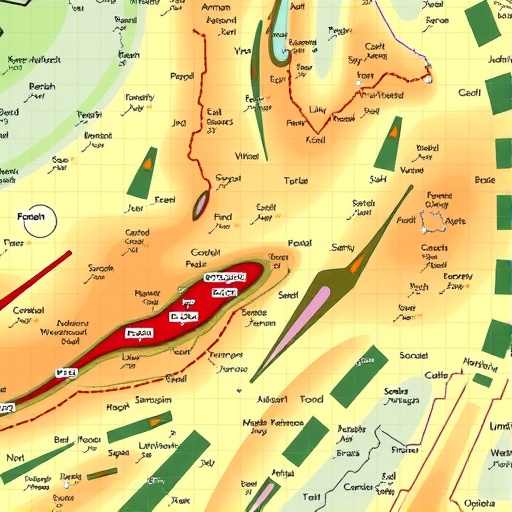The realm of zeolite synthesis is witnessing a revolutionary shift thanks to the advent of advanced computational methodologies. These crystalline materials, renowned for their applications in catalysis and adsorption, have long been synthesized using organic structure-directing agents (OSDAs). The choice of these OSDAs is not arbitrary; they significantly influence the type of zeolite formed and its inherent properties. However, the traditional approach to designing selective OSDAs has encountered substantial challenges due to the vast and intricate chemical space that exists between zeolites and their potential organic templates.
In a groundbreaking development, researchers have introduced ZeoBind, a novel computational workflow powered by machine learning. This innovation promises to streamline the exploration of the OSDA chemical space in a way that was previously unimagined. By harnessing advanced predictive modeling techniques, the team behind ZeoBind has constructed an exhaustive library of potential OSDAs, opening up new avenues for zeolite synthesis.
The significance of OSDAs in zeolite formation cannot be overstated. They act as templates that dictate the structural framework of the resulting zeolite. Variations in the OSDA structure can lead to substantial differences in the physicochemical properties of zeolites, affecting their efficacy in various applications, from catalysis to gas separation. Thus, optimizing OSDAs is crucial for tailoring zeolites to specific functions.
The methodology employed in ZeoBind enables the design and training of predictive models that capture the intricate interactions between zeolites and potential templating molecules. This model is grounded in a dataset comprising hundreds of thousands of data points, which has been meticulously curated to establish meaningful correlations between zeolite structures and OSDA features. The researchers have compiled a vast library of 2.3 million hypothetical OSDA-like molecules derived from commercially available precursors.
This extensive database not only enhances the understanding of zeolite-OSDA interactions but also facilitates the identification of promising candidates for experimental validation. In a remarkable screening effort, nearly 500 million pairs of zeolite-molecule combinations were assessed, leading to the discovery of two novel OSDAs that successfully template zeolites with unique compositions. The implications of this achievement are profound, as it marks a significant advance in the quest for efficient and selective zeolite synthesis.
What sets ZeoBind apart is its scalable approach, which democratizes access to critical data and tools necessary for OSDA design. By making this information open-access, the researchers aim to foster collaboration and stimulate further innovations in the field of zeolite chemistry. Such transparency is expected to entice additional researchers to explore this dynamic area, potentially leading to a flurry of new discoveries that enhance industrial applications of zeolites.
The computational power behind ZeoBind is an essential component of its success. By leveraging machine learning algorithms, the researchers can discern patterns and predict outcomes in the zeolite-OSDA space that would be nearly impossible to identify through traditional experimental approaches. This capability not only expedites the design process but also significantly reduces the cost and time associated with synthesizing and testing new OSDAs.
As industries continuously seek more efficient catalysts and adsorbents for various processes, the ability to design targeted zeolites could result in substantial economic and environmental benefits. For instance, zeolites find widespread applications in petrochemical refining, environmental remediation, and even renewable energy systems. The potential for optimally designed zeolites to enhance these processes makes the work surrounding OSDAs incredibly relevant.
In conclusion, the development of ZeoBind represents a monumental leap forward in zeolite synthesis. By elucidating the complex relationships between OSDAs and the resulting zeolite frameworks, this computational workflow lays the groundwork for significant advancements in both our understanding and utilization of these versatile materials. The future of zeolite research, empowered by machine learning and a comprehensive chemical space exploration, is not just promising—it’s ripe for discovery.
As researchers continue to explore and validate the findings from ZeoBind, we can anticipate a new era in zeolite chemistry that will yield materials tailored for increasingly specific applications. The combination of vast chemical libraries, predictive modeling, and empirical validation positions the scientific community on the brink of transformative breakthroughs in materials science.
As we reflect on these developments, it is becoming evident that artificial intelligence and machine learning are reshaping the landscape of chemical research. The integration of these technologies into traditional synthesis pathways allows for a paradigm shift in how we design and utilize materials. With tools like ZeoBind paving the way, the future of zeolite synthesis appears not only innovative but also crucial for addressing the challenges posed by modern-day industries.
In an age where efficiency and sustainability are paramount, the potential for tailored zeolites to revolutionize catalytic processes cannot be overlooked. As open-access initiatives gain momentum, the synergy between computational tools and experimental research will undoubtedly accelerate the discovery and application of novel materials crucial for a sustainable future.
The journey of exploring the zeolite–template chemical space is merely beginning, and with researchers taking bold steps forward, we eagerly await the next discoveries that will emerge from this exciting intersection of technology and chemistry.
Subject of Research: Zeolite synthesis and organic structure-directing agents (OSDAs) using computational workflows and machine learning.
Article Title: A comprehensive mapping of zeolite–template chemical space
Article References:
Xie, M., Schwalbe-Koda, D., Semanate-Esquivel, Y.M. et al. A comprehensive mapping of zeolite–template chemical space.
Nat Comput Sci 5, 661–674 (2025). https://doi.org/10.1038/s43588-025-00842-5
Image Credits: AI Generated
DOI: https://doi.org/10.1038/s43588-025-00842-5
Keywords: Zeolite synthesis, organic structure-directing agents, computational workflow, machine learning, predictive modeling, chemical space exploration.




